
Turismo en Asuán
Turismo en Asuán
Asuán no es solo una ciudad asombrosa, Asuán significa la belleza de la naturaleza y la grandeza de la historia representada en la antigua civilización faraónica, Asuán significa el calor del invierno y el esplendor del Nilo. El turismo en Asuán es una de las mejores decisiones que puede tomar.
Ubicación:
Asuán es una ciudad en el sur de Egipto, a unos 870 km al sur de El Cairo y aproximadamente a 180 km al sur de Luxor.
Panorama historico:-
Asuán es la antigua ciudad de Swenet. Swenet estaba ubicada en la principal ruta comercial entre Egipto y el sur, por lo que la antigua ciudad era la puerta de entrada a África. Los coptos lo llamaron "souan" que significa "comercio", del cual se deriva el actual Aswan.
El Clima en Asuán:
El clima en Aswan se considera un clima desértico. prácticamente no llueve durante el año. la temperatura media anual es de 26,8 C, durante los meses de enero, febrero y diciembre. La temperatura media está entre 20 C y 25 C.
Atracciones de Asuán:
El Museo nubia
En 1997 se estableció el museo internacional de Nubia. El museo de Nubia estaba dedicado a la civilización y la cultura nubias.
El obelisco inacabado
El Obelisco Inacabado es el obelisco antiguo más grande, es un tercio más grande que cualquier obelisco egipcio antiguo creado.
Isla Elefantina
La isla Elefantina es una isla en el Nilo, contiene muchos sitios arqueológicos.
Isla el Nabatat
La isla de Kitchener o isla botánica es una pequeña isla de forma ovalada.
Isla de Philae
Philae es una isla en el embalse de la presa baja de Asuán. El Templo de Philae, dedicado a la Diosa Isis, solía estar dentro de la isla antes de ser trasladado a otro lugar llamado Isla Agilika.
Museo de Asuán
El Museo de Asuán es un museo en Elefantina. El museo de Asuán se abrió al público en 1912.
Otros hitos y monumentos:
- Tumbas de los Nobles.
- El templo de la isla.
- Isla de Sehel
- Mausoleo de Agha khan
- Cementerio fatimí
- Presa de Asuán
- Presa de Aswan High
- Templo de Satis
- Templo de Hekayib
- Nilómetro de Khnum
- Qubbet Al Hawa
- Monasterio de San Simeón
- Templo de Kom Ombo
Navegue por las aguas azules a través de las dos franjas verdes a ambos lados del desierto dorado cuando reserve su crucero por el Nilo egipcio. Y consulte nuestras ofertas de temporada para elegir la pensión o casa de vacaciones más adecuada para sus vacaciones de Semana Santa 2024. Le ahorraremos las molestias e incluiremos algunos de los mejores hoteles y barcos en todas las ciudades que visite a través de los paquetes de viaje a Egipto. Pero si prefiere reservar su propio hotel, hemos personalizado profesionalmente para usted una amplia variedad de excursiones de un día a Egipto. Comience en la ciudad que nunca duerme y explore nuestras excursiones de un día a El Cairo, que abarcan todos los yacimientos arqueológicos y lugares de ocio, desde las Pirámides de Guiza, la famosa Esfinge y hasta el Museo Egipcio en la plaza El Tahrir y el Museo Nacional de la Civilización Egipcia para admirar la máscara dorada del rey Tutankamón. Y si le apetece acampar en uno de los desiertos más fascinantes del mundo, hemos creado las Rutas del Desierto Blanco. Viaje seguro con nosotros al Alto Egipto y reserve nuestras excursiones de un día a Luxor y viaje más al sur hasta la impresionante Nubia y explore todas las opciones que le ofrecen nuestras excursiones de un día a Asuán. La historia de Egipto nunca ha dejado de despertar las emociones y el deseo de descubrir los tesoros de este mundo faraónico.
Aswan is the land of gold, the land of good people. On its land, there are many different civilizations and cultures, and its warm, stable weather is unparalleled in the winter. With all these elements and others, Aswan has become a tourist destination that attracts the attention of the world.
Enjoy a wonderful vacation in the far south of Egypt, where these places vary between cultural, historical, and recreational.
Aswan is one of the beautiful and peaceful destinations in Egypt and lies farthest in the south of the country on the River Nile. With dramatic scenic beauty, ancient history, and an actively living Nubian culture, it is the kind of retreat no traveler ever forgets.
History
Pharaonic Egypt
The importance of this region emerged during the Old Kingdom, securing the southern border. It served as a center for armies when the kings of the Middle Kingdom attempted to extend their power southward. It was particularly important in the Egyptian war to drive out the Hyksos.
Ptolemaic Egypt
During the Ptolemaic era, the island of Philae—the seat of worship of the goddess Isis—received much attention, and they completed its great temple.
Roman Egypt
During the Roman era, temples were built in the ancient Egyptian style to attract the Egyptians. Emperor Trajan built a small temple on Philae Island.
With the spread of Christianity, it became the official religion in the fifth century AD, and Egyptian temples were transformed into churches.
The Islamic Era
Islam then spread from its inception; evidence written in Kufic script dating back to the early first century AH has been found.
Aswan flourished during the Islamic era, becoming a route to Azab on the Red Sea coast in the 10th century AD, from where ships sailed to the Hijaz, Yemen, and India.
During the sixth and seventh centuries AH, it was a significant cultural hub with three schools, the oldest of which were the Aswan School, Saifiya School, and Najmiya School in Aswan.
Modern Era
Muhammad Ali established the first military school in Egypt there in 1837.
Aswan is a gateway to the most famous historical sites of Egypt. Among its prime sites is the Philae Temple, which honored goddess Isis. The temple rests on an island with the Nile in the background. However, the historical value of the temple pales in front of its scenic beauty. The glory of the temple and its legends are rekindled during the Sound and Light Show at nightfall.
The Unfinished Obelisk, another interesting site, gives credit to the awe-inspiring stone craftsmanship of the ancient Egyptians. To the north lies the Temple of Kom Ombo, a unique temple dedicated to the two gods, Sobek and Horus. Abu Simbel's stunning temples are a must-have for any visit to Aswan. These colossal monuments carved right into the mountains speak for the architectural genius of Ramesses II and stand as a testament to his reign.
In the charming south, the river differs in form and subject from its nature in any other governorate in terms of purity and color, which, along with the color of the sky, form an artistic painting created by the Creator. Therefore, the Nile in the south forces you to visit it more than once.
The Nile takes on a peaceful beauty in Aswan. A ride on a felucca on its calm waters is one of the most suitable means of taking in the natural beauty of the location, especially when the sun sets into the riverbanks.
There are contemporary marvels that add to Aswan's beauty. The Aswan High Dam is an engineering marvel that not only controls the Nile waters but also created Lake Nasser, one of the world's largest artificial lakes. You can visit lesser-known gems from here like the Kalabsha Temple, hidden by the lake shores.
In Nubia, you'll find all the comforts, tranquility, and clear weather, making it an unparalleled eco-tourism destination in the far south of Egypt. As you set foot in Nubia and its villages, you'll find Nubian houses designed in the shape of domes, in cheerful colors, overlooking the Nile... You'll find women wearing the traditional Nubian gergar, and the markets are filled with handcrafted products and eco-friendly items, just as their fathers and grandfathers did.
Some of the murals tell the story of the amazing generosity and hospitality of the Nubian people, and their refined treatment of foreigners visiting their country. Enjoy the picturesque environment in the villages overlooking the Nile River, and spend a pleasant time surrounded by pure and attractive nature, generous hospitality, and the preparation of distinctive drinks and foods unique to the Nubian people, inherited from their fathers and grandfathers.
Aswan is Nubia's cultural capital, a city that is steeped in history and tradition. You should go to a Nubian village, where you can feel the hospitality of the people, the colorfulness of their houses, and their rich heritage. Taste traditional Nubian food, hear their distinct music, and see handmade handicrafts that narrate their history. It's something that stays with you.
One of Aswan's oldest marketplaces, the old tourist market is becoming more well-known and respected over time.
It's the biggest, busiest, and most dynamic commercial market. Aswan is full of tourist and natural attractions and tourist attractions, most notably the Tourist Market Street, which includes a large number of bazaars and markets specialized in selling gifts and souvenirs that carry the traditional style of the people of Aswan, in addition to handmade products such as accessories, porcelain, and clothes, as well as leather products and antiques, and selling local products such as clothes, handicrafts, ceramic utensils, gifts and souvenirs. There are also a lot of eateries on Aswan's Tourist Market Street. This is on top of leather goods, textiles, and fragrance items.
Aswan Market is a vibrant destination where the scent of spices fills the air and the eyes are treated to local handicrafts. Explore the souk to find treasures like handcrafted jewelry, colorful Nubian fabrics, and scented hibiscus tea—a local favorite and wonderful souvenir.


















